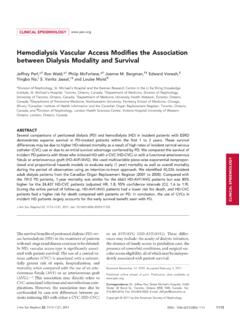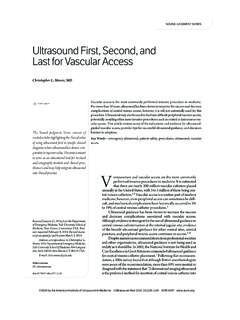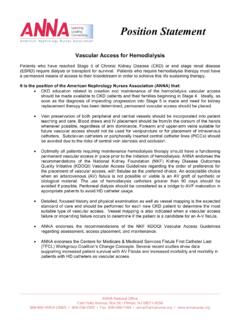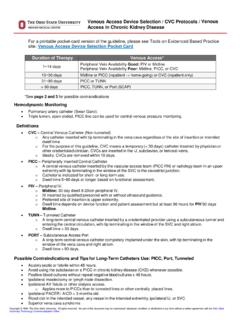Transcription of Vascular Access for Hemodialysis - dialysistech.net
1 Vascular Access for Hemodialysis Larry A. Scher, Professor of Clinical Surgery Division of Vascular Surgery Montefiore Medical Center Albert Einstein College of Medicine Bronx, New York 2013 NY Regional Meeting, September 29, 2013 Update on Hemodialysis Access Surgery Overview: K-DOQI and Fistula First Strategy for sequential Access placement AV fistula, AV graft, HeRO graft Fistula maturation Complications Causes of Hospitalization in New ESRD Patients Receiving Hemodialysis 33%23%12%12%19%40%17%10%3%31%0%10%20%30% 40%Dialysis AccessCardiovascularGastrointestinalNon- accessInfectionsOthersFirst 3 monthsAfter 3 monthsArora P, et al, J Am Soc Nephrol, 2000; 11:740-746 n = 128 Vascular Access : Europe vs. United States Dialysis Outcomes and Practice Patterns Study 6400 Hemodialysis patients in Europe (France, Germany, Italy, Spain and UK) and United States 80 % AVF Europe vs. 24% US in prevalent patients (2002 data) Initial Hemodialysis Access : Europe: 66% AVF, 2% AVG, 31% catheter US: 15% AVF, 24% AVG, 60% catheter Order or preference for AV fistulae Wrist (radiocephalic) AV fistula Elbow (brachiocephalic) AV fistula Goal: Increase the percentage of Hemodialysis patients using AV fistulas to 66% by 2009 Clinical Practice Guidelines for Vascular Access , Update 2006 Guideline 1.
2 Patient Preparation for Permanent Hemodialysis Access Guideline 2. Selection and Placement of Hemodialysis Access Guideline 3. Cannulation of Fistulae and Grafts and Accession of Hemodialysis Catheters and Port Catheter Systems Guideline 4. Detection of Access Dysfunction: Monitoring, Surveillance, and Diagnostic Testing Guideline 5. Treatment of Fistula Complications Guideline 6. Treatment of Arteriovenous Graft Complications Guideline 7. Prevention and Treatment of Catheter and Port Complications Guideline 8. Clinical Outcome Goals Guidelines on topics for management of patients with chronic kidney disease including Vascular Access DOQI Guideline 2: Selection of Permanent Vascular Access and Order of Preference for Placement of AV Fistulae Order or preference for AV fistulae Wrist (radiocephalic) primary AV fistula Elbow (brachiocephalic) AV fistula If either fistula not possible AV graft with synthetic material Transposed brachial basilic fistula Cuffed venous catheters should be discouraged as permanent Vascular Access Coalition to increase the use of AV fistulas for Hemodialysis Goal.
3 Increase the percentage of Hemodialysis patients using AV fistulas to 66% by 2009 As of 2010, 57% of Hemodialysis patients use AV fistulas, which is a 78% increase since the initiative began in 2003 Prevalent US Data AV F Use AV F Placed Graft Use CVC > 90 days CVC Use Total July 2003 Jan 2004 Jan 2005 Jan 2006 Jan 2007 Jan 2008 Jan 2009 Feb 2010 National AV Fistula Rate Reaches in December 2010 Principles of Hemodialysis Access surgery Strategy for long-term sequential Access placement Autogenous preferred Evaluation of arterial inflow and venous outflow Upper extremity over lower extremity Nondominant arm over dominant arm Forearm over upper arm Type of prosthetic graft material Cuffed venous catheters discouraged Belding Scribner 1921-2003 Chronic Hemodialysis using venipuncture and a surgically created arteriovenous fistula Michael J. Brescia, , James E. Cimino, , Kenneth Appel, and Baruch J.
4 Hurwich, NEJM 275:1089-1092, 1966. James E. Cimino (1928-2010) What is the best Access for Hemodialysis ? As we approach the 50th anniversary of the initial description of the AV fistula, it still remains the best Access for Hemodialysis . Primary Arteriovenous Fistula Advantages superior patency fewer complications (infection, arterial steal) easy revision single anastomosis Disadvantages frequent thrombosis of forearm veins delayed maturation (4-6 weeks) difficult cannulation ? lower flow rates Evaluation of Sites for AV Fistula Physical examination / duplex ultrasound Suitability of vein Diameter above mm. for AV fistula Diameter above mm. for AV graft Continuity with deep and central vein Absence of stenosis Suitability of artery Arterial lumen greater than mm. Absence of obliterating calcification Patency of palmar arch (?) Sites for AV Fistula radiocephalic snuffbox antecubital (brachiocephalic) transposed basilic vein upper arm forearm Snuffbox AV Fistula Radiocephalic AV Fistula Proximal Radial Artery Fistula Alternative when wrist fistula not feasible Adequate arterial inflow but reduced risk of steal compared to brachial artery fistulas Venous anatomy critical deep perforating branch of median antebrachial vein Excellent patency rates Forearm basilic vein transposition Silva et al.
5 (JVS 1997;26:981-6) Duplex evaluation of forearm arteries and veins Increased utilization of autogenous veins for AV Access with transposition techniques Forearm Basilic Vein Transposition Upper Arm Basilic Vein Transposition Basilic vein in upper arm often satisfactory conduit even in the presence of extensive thrombosis of forearm veins Deep anatomic position on medial aspect of upper arm makes venipuncture difficult Satisfactory Access depends on transposition of basilic vein into subcutaneous tunnel Can be done in one or two stages Basilic Vein Transposition Basilic Vein Transposition Single vs Two Stage Basilic Vein Transposition Western Vascular Society 2010 Patency rates appear to be improved with the two- stage brachio-basilic AV F Configuration of Upper Extremity AV Grafts Loop Forearm Straight Forearm Brachioaxillary Normal Upper Extremity Anatomy Arterial Anatomy Venous Anatomy Alternative Graft Materials for Hemodialysis Access (Saphenous vein) (Bovine heterograft) (Umbilical vein) (Dacron) PTFE Polyurethane (VectraR) Bovine mesenteric vein (ProColR ) Cryopreserved femoral vein allograft (CryoVeinR) Bovine carotid artery (Artegraft) What is the best graft material for Hemodialysis Access ?
6 Almost 40 years after the introduction of PTFE graft material for dialysis Access , no alternative graft material has been proven to be better. Neointimal Hyperplasia One-site-itis Destruction of PTFE graft material by repeated puncture at one site. Goals of modifying graft materials Improve 10 and 20 patency Reduce complications Pseudoaneurysms Infection Vascular steal Facilitate early Access Reduce bleeding after puncture Facilitate thrombectomy PTFE Graft Modifications for Improved Hemodialysis Access Patency Rings Outer wrap Taper Wall thickness Venous cuff Carbon coating Tunneling sheaths Pore size Stretch Swirl ProcolR SliderTM VectraR SwirlGraft Alternative Graft Materials For Hemodialysis Access Artegraft Acuseal HeRO VenafloTM Graft Hooded AVG (Designed to provide stable, organized laminar high flow into veins to prevent intimal hyperplasia) One-piece construction with cuff designed to be trimmed to match recipient vein size Gore Propaten Graft Heparin bonded Improved patency?
7 VectraR Vascular Access Graft Multilayered, self-sealing polyurethane Vascular Access graft (PVAG) Technical complications (eg-kinking) can be avoided by using a double sheathed implant technique. Early Access is possible without sacrificing long-term performance. Time to hemostasis after cannulation significantly reduced Atrium FlixeneTM Vascular Graft next generation composite graft proprietary biomaterial film lamination process improved strength kink resistance surgical handling resistance to weeping GORER Acuseal Graft low-bleed, tri-layer Vascular graft elastomeric middle membrane between inner and outer layers of expanded polytetrafluoroethylene (ePTFE). hinders suture line and cannulation needle bleeding. may reduce the risk of seroma and pseudoaneurysm formation ProColR Vascular Bioprosthesis Bioartificial Vascular conduit derived from bovine mesenteric vein. ProColR safe alternative to PTFE for Hemodialysis Access with superior patency in high-risk patients prone to Access -related thrombosis.
8 A Prospective, Randomized Comparison of Bovine Carotid Artery and Expanded Polytetrafluoroethylene for Permanent Hemodialysis Vascular Access Journal of Vascular Surgery, Volume 53, Issue 6, Pages 1640-1648, June 2011. Conclusion The BCA graft is an excellent option for patients on Hemodialysis that are not suitable for native arteriovenous fistulas, as these grafts required fewer interventions than the ePTFE grafts to maintain patency. The GORE Hybrid Vascular Graft is an expanded Polytetrafluoroethylene (ePTFE) Vascular prosthesis that provides a streamlined solution for challenging dialysis Access . HeRO Device Avoids venous anastomosis by transitioning ePTFE graft with traditional arterial anastomosis into single-lumen silicone catheter inserted via internal jugular vein into the SVC or RA Conduit fully implanted and accessed in typical percutaneous fashion Catheter portion secures venous outflow only and avoids fibrin sheath-mediated inflow restriction Alternative options for AV Access Chest wall Lower extremity Lower Extremity AV Grafts Taylor et al.
9 (Am Surg 1996;62:188-91) 45 leg AV grafts in 39 patients Primary patency 47% at 24 months Infection 18%, leg ischemia 16% Marker for late mortality Vogel et al. (South Med J 2000;93:593-5) 134 (16% of all AV grafts) patients 62% 12 month graft survival Mean graft patency months Infection 46%, thrombosis within 1 month 28% Arteriovenous fistula with transposed superficial femoral vein Gradman et al., JVS 33:968,2001 25 patients Twelve month 10 patency 73% Twelve month 20 patency 86% Thrombosis, fistula infection and venous hypertension uncommon Wound complications and steal syndrome problematic Disadvantages of Tunneled Cuffed Catheters Lower blood flow rates High morbidity due to thrombosis and infection Discomfort and cosmetic disadvantage of an external appliance Shorter expected use-life than other Access types NKF-K/DOQI Clinical Practice Guidelines for Vascular Access , 2000. Am J Kidney Dis, 2001; 37(Suppl. 1):S137-S181 Innovative Surgical Approaches to Maximize Arteriovenous Fistula Creation Shenoy, Seminars in Vascular Surgery 2007 Fistula Maturation Buttonhole Cannulation Effect of Clopidogrel on Early Failure of Arteriovenous Fistulas for Hemodialysis Dialysis Access Consortium Study Group, Dember et al, JAMA, 2008 Clopidogrel reduces frequency of early thrombosis of new AVF but does not increase proportion of fistulas that become suitable for dialysis (nonmaturation) Failure to attain suitability for dialysis (877 patients) Clopidogrel group ( ) Placebo group ( ) Options to deal with poor fistula maturation Fewer fistulas, more grafts (vein size?)
10 Better patient selection (age?) Aggressive assessment of immature or failing fistulas at 4-6 weeks with 20 intervention Surgical revision Endovascular therapy Balloon maturation Interventions to Salvage Fistulas With Early Failure Balloon angioplasty of lesions Accessory vein obliteration One state vs. sequential dilatation Surgical revision Typical Juxta-anastomotic Venous Stenosis Surgical Revision of AVF Juxta-anastomotic Stenosis Berman, et al, J Vasc Surgery, 2001 Beathard, Semin Dial, 2005 Angioplasty of AVF Juxta-anastomotic Stenosis Beathard, Gerald A. An Algorithm for the Physical Examination of Early Fistula Failure. Seminars in Dialysis 18 (4), 331-335. Fig. 3. (a) Accessory vein: (A) accessory vein, (B) fistula. (b) Collateral vein: (A) fistula, (B) collateral (below stenosis), (C) stenosis, (D) accessory vein (above stenosis), (E) upper fistula. (A)Poorly maturing wrist fistula - catheter placed retrograde into the radial artery via the fistula.











